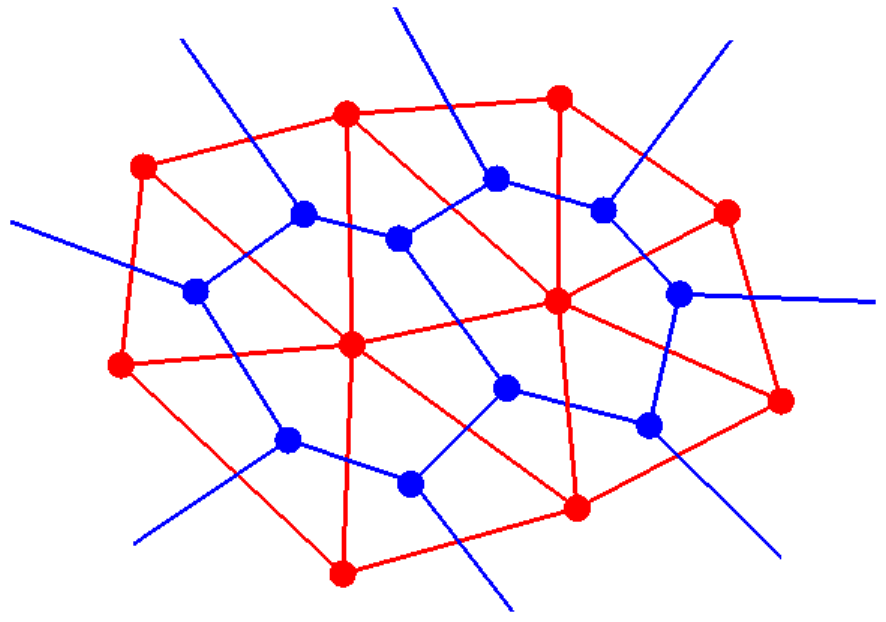- Consider the Mesh and its Dual Simultaneously

- Vertices and Faces switch roles, we just re-label them
- Edges remain Edges
Now there are eight ways to look at each edge
- Four ways to look at primal edge
- Four ways to look at dual edge
- Bug Demo (reprise)
Relations Between Edges: Edge Algebra
- Elements in Edge Algebra:
- Each of 8 ways to look at each edge
- Operators in Edge Algebra:
- Rot: Bug rotates 90 degrees to its right
- Sym: Bug turns around 180 degrees
- Flip: Bug flips up-side down
- Onext: Bug rotates CCW about its origin (either Vertex or Face)
- Some Properties of Flip, Rot, and Onext:
e Rot4 = ee Rot2 != ee Flip2 = ee Flip Rot Flip Rot = ee Rot Flip Rot Flip = ee Rot Onext Rot Onext = ee Flip Onext Flip Onext = e
- Properties of Edge Algebra deduced from those above:
e Flip-1 = e Flipe Sym = e Rot2e Rot-1 = e Rot3e Rot-1 = e Flip Rot Flipe Onext-1 = e Rot Onext Rote Onext-1 = e Flip Onext Flip
- Other Useful Definitions:
e Lnext = e Rot-1 Onext Rote Rnext = e Rot Onext Rot-1e Dnext = e Sym Onext Sym-1
- Even More Useful Definitions:
e Oprev = e Onext-1 = e Rot Onext Rote Lprev = e Lnext-1 = e Onext Syme Rprev = e Rnext-1 = e Sym Onexte Dprev = e Dnext-1 = e Rot-1 Onext Rot-1NOTE: Every function defined so far can be expressed as a constant number of Rot, Flip, and Onext operations! This is independent of the local topology and the global size and complexity of the mesh.
One QuadEdge Structure per Edge, with 4 Parts
- Pick 4 of the 8 Edge elements on a single side
- Can represent flipped versions with an extra bit
- Each part has 2 pointers, "Data" and "Onext"
- Demo
"Data" Pointer
- Geometric and Attribute Information
- Application Specific
- No Effect on Adjacency Operations
"Onext" Pointer
- Pointer to Onext Edge element
- CCW element around Origin of edge (either a Vertex or a Face)
Four Parts to an Edge -> Four Loops
- Each element is a node in 1 of 4 linked lists
- Loop around Face on both sides of Edge
- Loop around Vertex on both ends of Edge
Duality
- The QuadEdge structure represents both the mesh and its dual simultaneously
- Therefore, computing the dual is easy:
QuadEdgeMesh::ComputeDual() { }